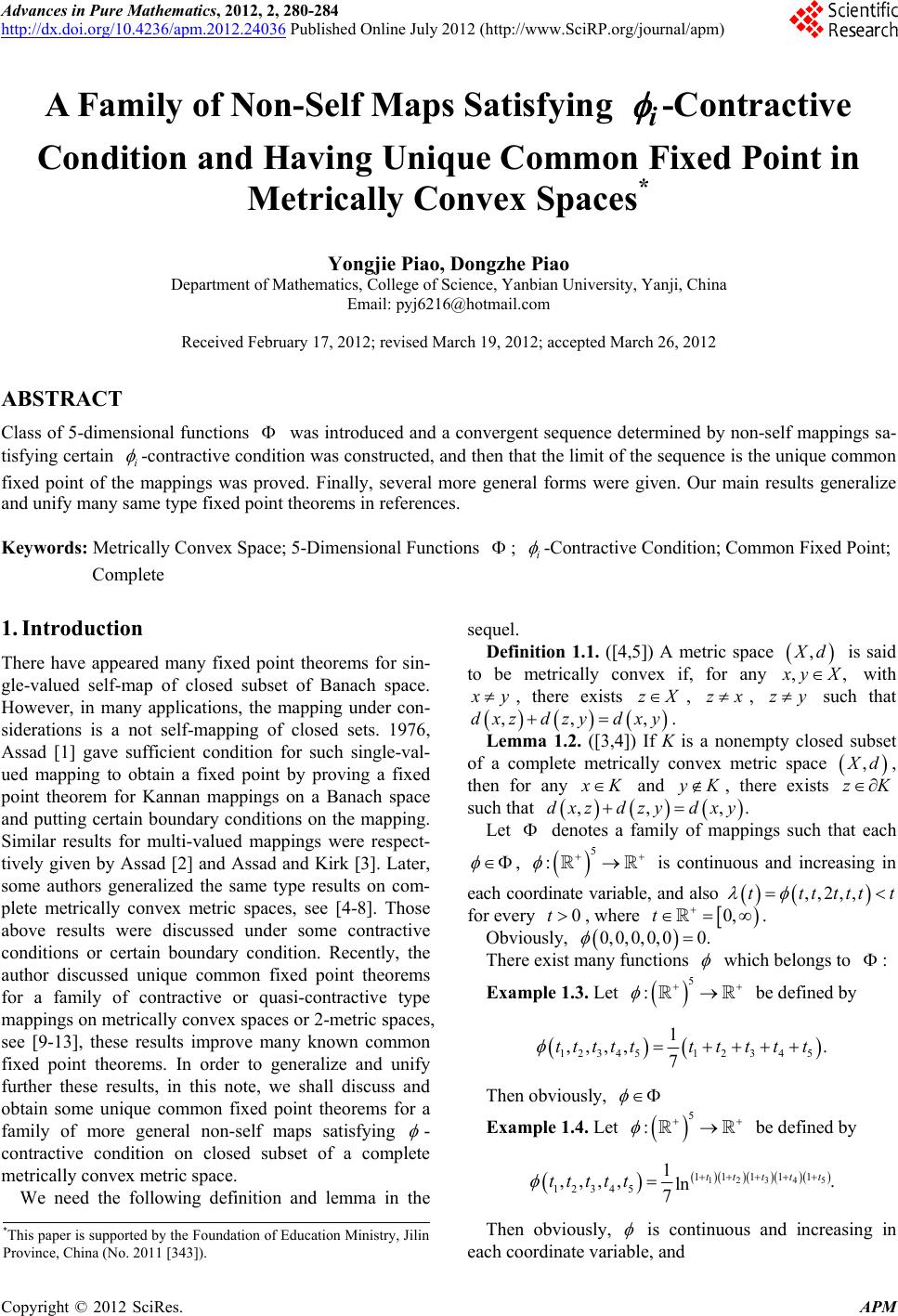 Advances in Pure Mathematics, 2012, 2, 280-284 http://dx.doi.org/10.4236/apm.2012.24036 Published Online July 2012 (http://www.SciRP.org/journal/apm) A Family of Non-Self Maps Satisfying i i -Contractive Condition and Having Unique Common Fixed Point in Metrically Convex Spaces* Yongjie Piao, Dongzhe Piao Department of Mathematics, College of Science, Yanbian University, Yanji, China Email: pyj6216@hotmail.com Received February 17, 2012; revised March 19, 2012; accepted March 26, 2012 ABSTRACT Class of 5-dimensional functions was introduced and a convergent sequence determined by non-self mappings sa- tisfying certain -contractive conditio n was constructed , and then that the limit of the sequence is the unique common fixed point of the mappings was proved. Finally, several more general forms were given. Our main results generalize and unify many same type fixed point theorems in references. Keywords: Metrically Convex Space; 5-Dimensional Fu nc t io ns ; i -Contractive Condition ; Common Fixed Point; Complete 1. Introduction There have appeared many fixed point theorems for sin- gle-valued self-map of closed subset of Banach space. However, in many applications, the mapping under con- siderations is a not self-mapping of closed sets. 1976, Assad [1] gave sufficient condition for such single-val- ued mapping to obtain a fixed point by proving a fixed point theorem for Kannan mappings on a Banach space and putting certain boundary conditions on the mapping. Similar results for multi-valued mappings were respect- tively given by Assad [2] and Assad and Kirk [3]. Later, some authors generalized the same type results on com- plete metrically convex metric spaces, see [4-8]. Those above results were discussed under some contractive conditions or certain boundary condition. Recently, the author discussed unique common fixed point theorems for a family of contractive or quasi-contractive type mappings on metrically convex spaces or 2-metric spaces, see [9-13], these results improve many known common fixed point theorems. In order to generalize and unify further these results, in this note, we shall discuss and obtain some unique common fixed point theorems for a family of more general non-self maps satisfying - contractive condition on closed subset of a complete metrically convex metric space. We need the following definition and lemma in the sequel. , Definition 1.1. ([4,5]) A metric space d ,, is said to be metrically convex if, for any yX with y , there exists zX , , such that zxzy ,, ,dxz dzydxy. Lemma 1.2. ([3,4]) If K is a nonempty closed subset of a complete metrically convex metric space , d, then for any K KzK, there exists and such that ,, ,.dxz dzydxy Let denotes a family of mappings such that each 5 : ,,2,,ttt tttt is continuous and increasing in , each coordinate variable, and also 0t 0,t for every , where . 0,0,0,0,0 0 . Obviously, which belongs to : There exist many functions 5 : Example 1.3. Let be defined by 12345 12345 1 ,,,, . 7 ttttt ttttt Then obviously , 5 : Example 1.4. Let be defined by 12345 11111 12345 1 ,,,, ln 7ttttt ttttt . Then obviously, is continuous and increasing in each coordinate variable, and *This paper is supported by the Foundation of Education Ministry, Jilin Province, China (No. 2 01 1 [ 343]). C opyright © 2012 SciRes. APM 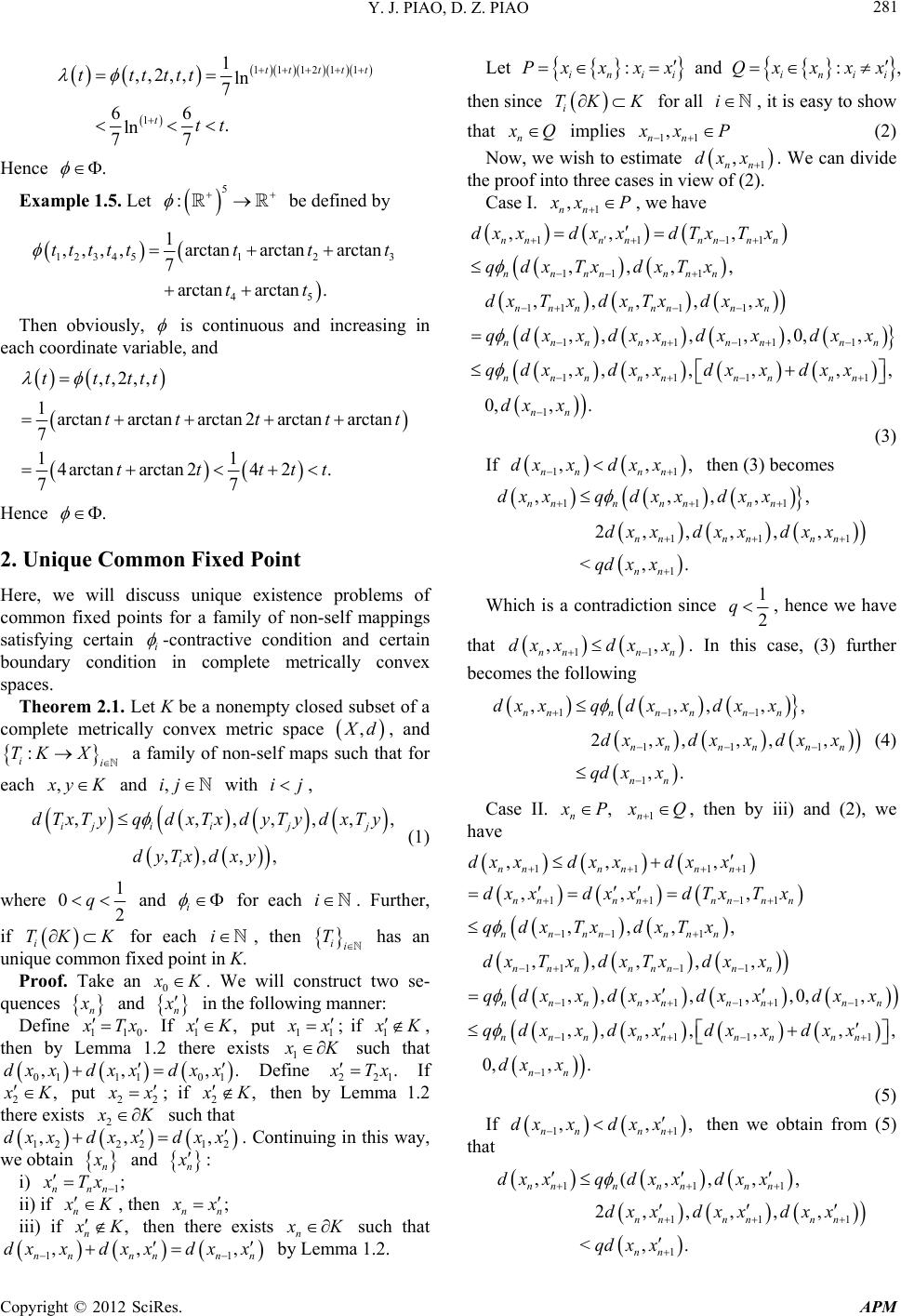 Y. J. PIAO, D. Z. PIAO 281 111211tt ttt . 1 1 ,,2,, ln 7 66 . ln 77 t ttt ttt tt Hence 5 Example 1.5. Let be defined by : 12345 1 1 , ,, ,arctanarctan 7 arctan arctan ttttt t 2 3 45 arctan . t t tt Then obviously, is continuous and increasing in each coordinate variable, and ,,2,, 1arctanarctanarctan 2arcta 7 11 4arctanarctan 242 77 ttt ttt tt ttt n arctan . ttt tt . Hence 2. Unique Common Fixed Point Here, we will discuss unique existence problems of common fixed points for a family of non-self mappings satisfying certain i -contractive condition and certain boundary condition in complete metrically convex spaces. Theorem 2.1. Let K be a nonempty closed subset of a complete metrically convex metric space , d :i TK X , and i a family of non-self maps such that for each , yK and with i, ,ijj ,,,, j j y dxTy ,,, ,,,, ij ii i dTxTyqdxTx dyT dyTx dxy (1) where 1 0i 2 q and TKii T 0 for each i. Further, if i for each , then has an unique com mon fixed point in K. Ki Proof. Take an K . We will construct two se- quences n and n . in the following manner: Define 110 Tx If 1, K put 11 x; if 1 K , then by Lemma 1.2 there exists 1 K 1 . . such that 0 Define 221 01 x 1 dxx , 1 ,,dx xdx Tx If 2, K put 22 x ; if 2, K then by Lemma 1.2 there exists 2 K 2 ,dxx such that x 12 dx x , 12 2. Continuing in this way, we obtain ,dx n and n : i) 1; nnn Tx ii) if n K , then ; nn x iii) if , n K then there exists n K , n n x such that by Lemma 1.2. ,, nnn x dxx 11n dx dx Let : inii Pxxxx and : inii xxxQx , then since i TK K i n for all , it is easy to show that Q implies 11 , nn xP ,dxx 1 , nn (2) Now, we wish to estimate 1nn. We can divide the proof into three cases in view of (2). xP , we have Case I. 1111 11 1 111 1 11111 1111 1 ,, , ,,,, ,,,,, ,,,, ,,0,, ,,, ,,,, 0,, . nnn nnnn n nnnn nnn nnn nnnnn nnn nnnnnn nnnnnnnnn nn dxxdxxdTxT x qdxTx dxTx dxT xdxTxdxx qdxxdxx dxxdxx qdxxdxxdxx dxx dx x (3) 11 ,,, nn nn dx xdxx then (3) becomes If 111 111 1 ,,,,, 2,,,,, <,. nnn nnnn nn nn nn nn dxxqdxxdxx dxx dxxdxx qd xx Which is a contradiction since 1 2 q, hence we have that 11 ,, nnn n dxxdx x . In this case, (3) further becomes the following 111 111 1 ,,,,, 2,,,,, ,. nnnn nn n nn nn nn nn dxxqdx xdx x dxxdxxdxx qd xx , n (4) P Case II. 1n Q , then by iii) and (2), we have 1111 1111 11 1 111 1 11111 111 ,, , ,, , ,,,, ,,,,, ,, , ,, ,0,, ,, , ,, nnnnn n nnnnnnnn nnnn nnn nnn nnnnn nnnnnnnnn nnn nnn dx xdx xdxx dx xdx xdTxTx qdxTx dxTx dxTxdxTxdxx qdx xdxxdx xdx x qdxxdxx dxx 1 1 ,, 0,, . nnn nn dx x dx x (5) 11 ,,, nn nn dx xdxx If then we obtain from (5) that 111 111 1 , (,,,, 2,,,,, <,. nnn nnnn nn nn nn nn dxxqdxxdxx dxx dxxdxx qd xx Copyright © 2012 SciRes. APM 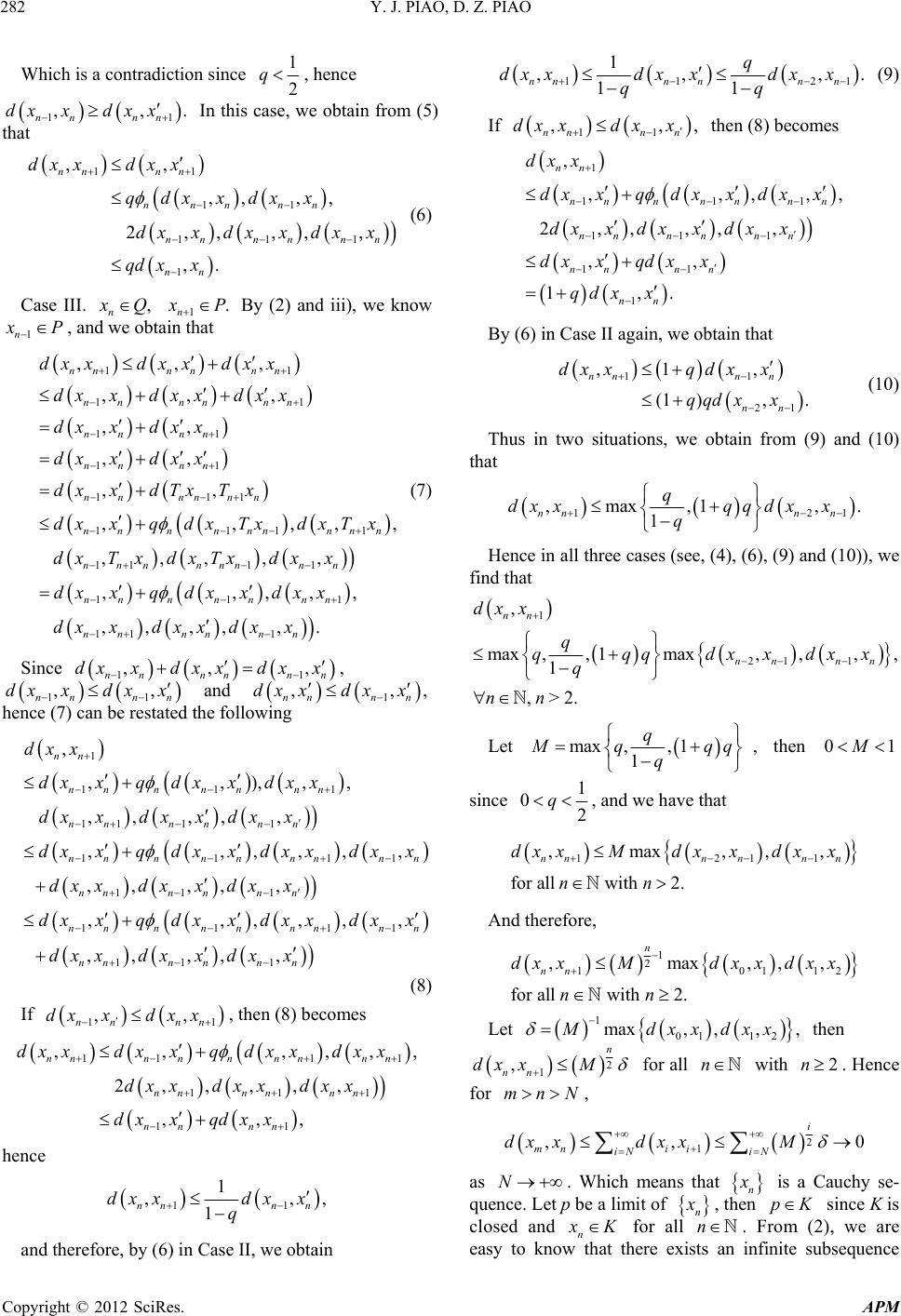 Y. J. PIAO, D. Z. PIAO 282 Which is a contradiction since 1 2 q 1 ,,. nn dxx 111 ,, ,, nn nn x dx x , , hence dx x 1nn In this case, we obtain from (5) that 11 11 1 ,, ,, 2,,, ,. nn nn nnn nnnn nn dxx dxx qdxxdx dx xdxx qd xx (6) Case III. n Q 1. n P By (2) and iii), we know 1n P , and we obtain that 11 11 11 11 111 11 11 1 1 ,, ,, ,, ,, ,, ,, ,,,, , nnnn nn nn nn nn nn nn nn nn nn nnnn nnn nnn nnn nnn nn dxxdxx dxx dxxdxx dxx dx xdxx dx xdxx dxxdTxT x dxxqdx Tx dxT xdxTxd dx x 111 ,, ,,,,, nnn nnnn nn qdxxd dxxdxxdxx 11 1 , , ,,, , nnn n n dxT x x x 11 , , . nn xx ,dx x (7) Since ,, nnn dx xdxx 11nnn 1 ,,, n n dx x 1 11 11 ,, ,,, ,,, n nn nn dx x dx x 11 ,, nn dxx , ,,dx xdx x 11nn nn and hence (7) can be restated the following nn dx x 1 11 11 11 11 11 1 11 11 , ,,), ,, ,, , ,,, ,, ,,, ,,, ,, , nn nnn nnn nnnn nn nnn nnnn nnn nn n nnn nnnn nn n dx x dx xqdx xdxx dx xdx xdx x dx xqdx xdxx dx xdxxdxx dx xqdx xdxx dx xdx 1 ,, nnn xdxx (8) If , then (8) becomes nn dx x 1 1 111 ,,,, ,, , nn nn dxx xx 11 11 , , 2,,, ,, nnn nnnn nn nn nn nn dxxdxxq dxx dxx dxxd dx xqdxx hence 11 ,, , n n dx x q 1 1 nn dxx and therefore, by (6) in Case II, we obtain 11 21 1 ,,,. 11 nnn nnn q dxxdx xdxx qq (9) 11 ,,, nnn n dxxdxx then (8) becomes If 1 111 111 11 1 , ,,,,, 2,,,,, ,, 1,. nn nnn nnnn nn nn nn nn nn nn dxx dx xqdxxdxx dxx dxxdxx dx xqdxx qdxx By (6) in Case II again, we obtain that 11 21 ,1 , (1 ),. nnn n nn dxxqdx x qqdxx (10) Thus in two situations, we obtain from (9) and (10) that 121 ,max,1 ,. 1 nnn n q dxxqqdx x q Hence in all three cases (see, (4), (6), (9) and (10)), we find that 1 211 , max,, 1max,,, 1 ,>2. nn nn nn dxx q qqqdxxdxx q nn , Let max,, 1 1 q qqq q 01M , then since 1 02 q, and we have that 1211 ,max,,, forallwith2. nnnnn n dxxMdxxdx x nn And therefore, 1 2 10112 ,max,,, forallwith2. n nn dx xMdxxdxx nn Let 1 01 12 max, ,,,Mdxxdxx then 2 1 ,n nn dx xM n2n mnN for all with . Hence for , 2 1 ,, 0 i mn ii iN iN dx xdxxM N as . Which means that n is a Cauchy se- quence. Let p be a limit of n , then since K is closed and n pK K for all n. From (2), we are easy to know that there exists an infinite subsequence Copyright © 2012 SciRes. APM 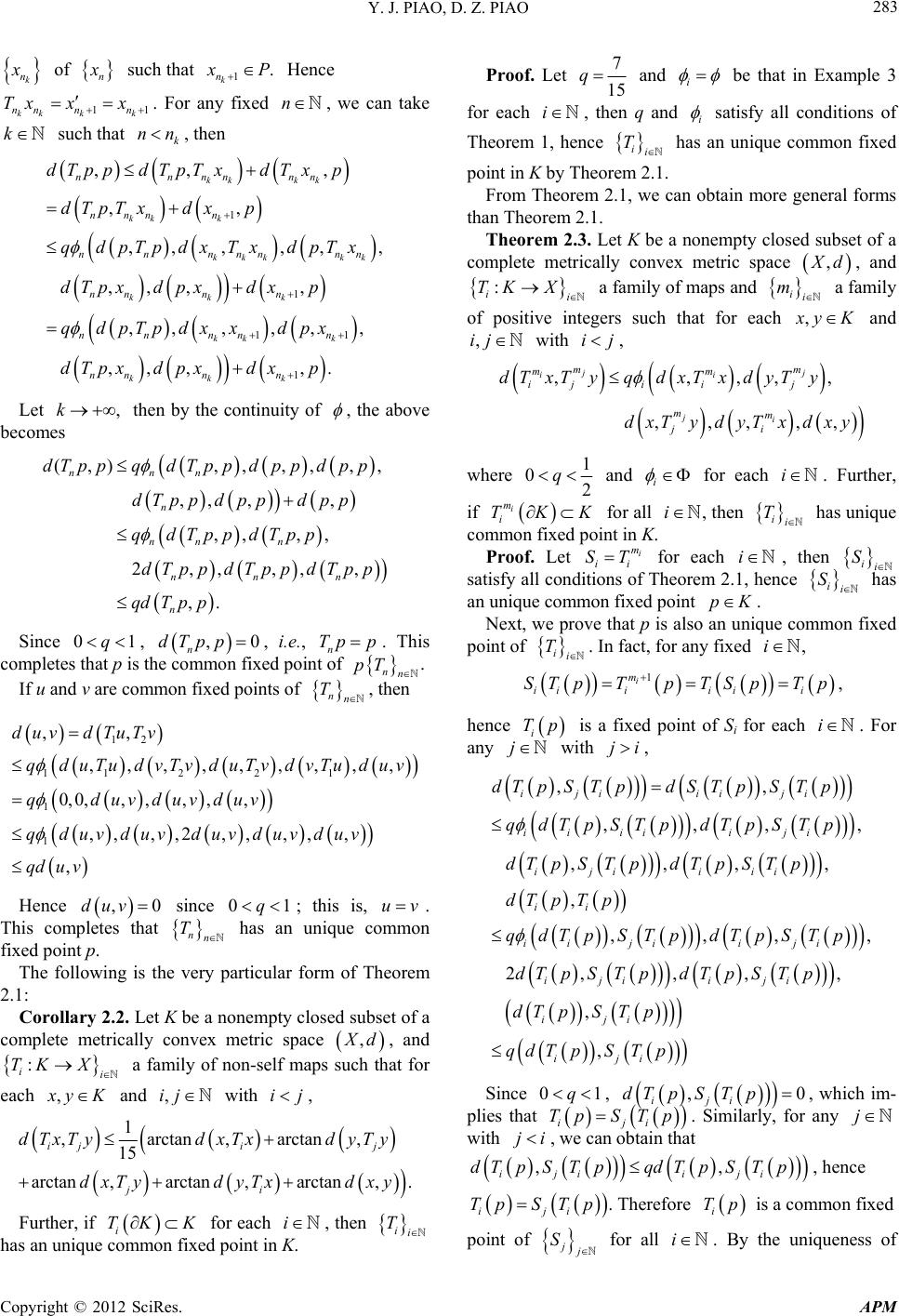 Y. J. PIAO, D. Z. PIAO 283 k n of n such that 1. k n P 1 k k n n x x n kk nn 1 11 1 , ,, , ,, , ,. kk kk k k k nn n nn n n n Txp dpTx p dpx p ,k Hence 1 kk nn Tx . For any fixed , we can take such that , then 1 ,, ,, ,,,, ,,, ,, , ,,, kk kk k kkk kk kk kk nn nn nnnn nnnn nn n nnnn nn n dTppdTpTxd dTpTxdx p qdpTpdxTx dTpxd pxdx qdpTpdxx dTpxd pxdx Let then by the continuity of , the above becomes ,, ,, , ,, ,, n nnn pd pp d pp p p dTpp dT (,),, ,, , ,, 2,,, ,. nnn n nn n dTppqdTppdp dTppd pp qdTppdTp dTpp dTp qdTpp Since , n 01q ,0pp , i.e., n. This completes that p is the common fixed point of Tp p n pT n If u and v are common fixed points of . nn T 1 ,,, , Tud uv d uv du 0qv , then 12 11 22 1 1 ,, ,,,,,, 0,0, ,,,, , ,,,,2 ,,,, , duvdTuTv qduTudvTvd uTvd v qd uvd uvd uv qd uvd uvd uvd uv qdu v Hence since ; this is, u ,0v1 . This completes that n Tn , has an unique common fixed poi nt p. The following is the very particular form of Theorem 2.1: Corolla ry 2 .2. Let K be a nonempty closed subset of a complete metrically convex metric space d :i TK X , and i a family of non-self maps such that for each , yK and with i, ,ijj 1 ,arctan ,arctan 15 arctan ,arctan,ar ij i ji d TxTydxTx dxTydyTx , ctan, . j d yTy dxy TK Further, if i for each i, then K ii T has an unique common fixed poi nt in K. Proof. Let 7 15 q and i i be that in Example 3 i , then q and for each satisfy all conditions of Theorem 1, hence ii T , has an unique common fixed point in K by Theorem 2.1. From Theorem 2.1, we can obtain more general forms than Theorem 2. 1. Theorem 2.3. Let K be a nonempty closed sub set of a complete metrically convex metric space d, and : ii TKX ii m , a family a family of maps and yK and of positive integers such that for each ,ij ij with , ,,,,, ,,,,, jj ii ji mm mm iji ij mm ji dT xTyqdxT x dyTy dxTy dyT xdxy where 1 02 qi for each . Further, i and i m TKK i for all i if ii T i m STi , then has unique common fixed point in K. Proof. Let ii for each , then i Si satisfy all conditions of Theorem 2.1, hence ii S pK has an unique common fixed point . Next, we prove that p is also an unique common fixed point of ii T i. In fact, for any fixed , 1 i m ii iii i STp TpTSp Tp , i Tp i is a fixed point of Si for each hence j. For any ji with , ,, ,,,, ,,,, , ,,,, 2, ,, , , , ijiii ji ii iiiji iji iii ii iijii ji iji iji iji iji dTpSTpdSTp STp q dTpSTpdTpSTp dT p S T pdTp STp dT pT p q dTpSTpdTpSTp dT p S T pdTp S T p dT pST p qdT pST p 01q , Since ,0 ij dT p S T p i, which im- plies that Tp STpj iji . Similarly, for any ji with , we can obtain that ,, iji iji dTpSTp qdTpSTp, hence . Therefore is a common fixed iji Tp STp i Tp point of jj S i for all . By the uniqueness of Copyright © 2012 SciRes. APM 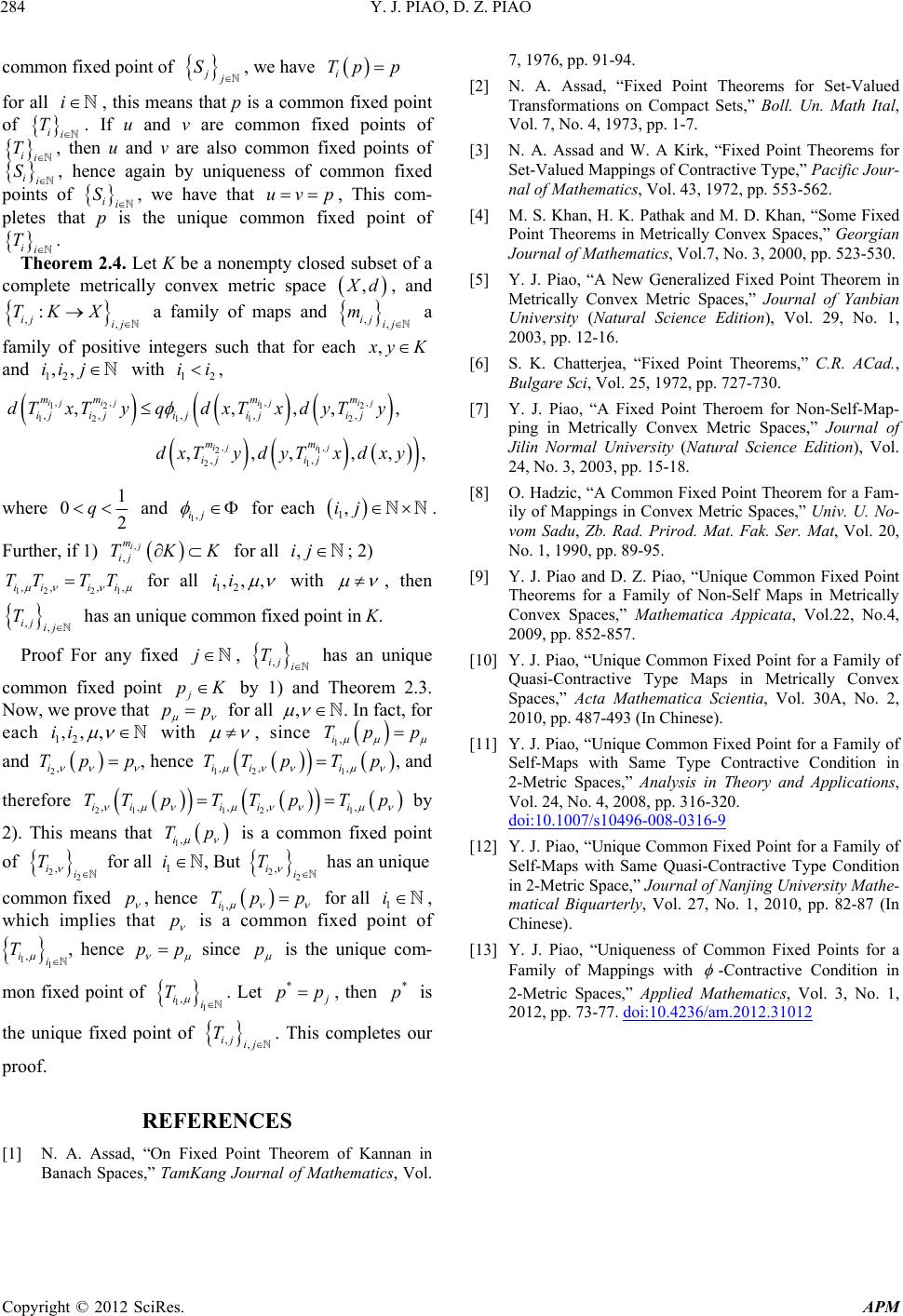 Y. J. PIAO, D. Z. PIAO Copyright © 2012 SciRes. APM 284 j S i Tp p common fixed point of j , we have for all , this means that p is a common fixed point of i. If u and v are common fixed points of , then u and v are also common fixed points of ii, hence again by uniqueness of common fixed points of ii, we have that , This com- pletes that p is the unique common fixed point of . i i T ii T SSuvp , i Ti Theorem 2.4. Let K be a nonempty clo sed subset of a complete metrically convex metric space d , ij TK X ,, ij ij m , and ,: ij a family of maps and , a family of positive integers such that for each yK and with , 12 ii 12 ii , 2 2 , ,, ,,, i j j m ij yT y x dxy ,,j ,, , 12 1 121 1 ,, 21 21 ,,, , ,, ,, ,,, ijijij ij i mm m ij ijijij mm ij ij dT xTyqdxTxd dxTydyT , where 1 2 q01,ij 1,ij and for each ,ij m ij TK . Further, if 1) for all ; 2) , 12 2 ,, ,iii TT K,ij 1 ,i TT for all 12 ,, ,ii with , then has an unique common fixed point in K. , ij ,ij T Proof For any fixed , has an unique j ,iji T j pKcommon fixed point by 1) and Theorem 2.3. Now, we prove that pp for all , . In fact, for each 12 ,, ,ii with , since Tp 1,ip 2,i and Tp p , hence p 1 ,i T p 12 ,,ii TT 211 2 ,,, ,ii ii TT pTT 1 ,i pT p , and therefore Tp by 2). This means that 1,i 1 i is a common fixed point of for all , But i T 22 ,i 22 ,ii T has an unique common fixed p , hence 1,i pTp for all 1 i , which implies that p is a common fixed point of 11 ,i i Tp , hence p since p is the unique com- mon fixed point of . Let 11 ,i i T* pp* p ,ij , then is the unique fixed point of . This completes our proof. ,ij T REFERENCES [1] N. A. Assad, “On Fixed Point Theorem of Kannan in Banach Spaces,” TamKang Journal of Mathematics, Vol. 7, 1976, pp. 91-94. [2] N. A. Assad, “Fixed Point Theorems for Set-Valued Transformations on Compact Sets,” Boll. Un. Math Ital, Vol. 7, No. 4, 1973, pp. 1-7. [3] N. A. Assad and W. A Kirk, “Fixed Point Theorems for Set-Valued Mappings of Contractive Type,” Pacific Jour- nal of Mathematics, Vol. 43, 1972, pp. 553-562. [4] M. S. Khan, H. K. Pathak and M. D. Khan, “Some Fixed Point Theorems in Metrically Convex Spaces,” Georgian Journal of Mathematics, Vol.7, No. 3, 2000, pp. 523-530. [5] Y. J. Piao, “A New Generalized Fixed Point Theorem in Metrically Convex Metric Spaces,” Journal of Yanbian University (Natural Science Edition), Vol. 29, No. 1, 2003, pp. 12-16. [6] S. K. Chatterjea, “Fixed Point Theorems,” C.R. ACad., Bulgare Sci, Vol. 25, 1972, pp. 727-730. [7] Y. J. Piao, “A Fixed Point Theroem for Non-Self-Map- ping in Metrically Convex Metric Spaces,” Journal of Jilin Normal University (Natural Science Edition), Vol. 24, No. 3, 2003, pp. 15-18. [8] O. Hadzic, “A Common Fixed Point Theorem for a Fam- ily of Mappings in Convex Metric Spaces,” Univ. U. No- vom Sadu, Zb. Rad. Prirod. Mat. Fak. Ser. Mat, Vol. 20, No. 1, 1990, pp. 89-95. [9] Y. J. Piao and D. Z. Piao, “Unique Common Fixed Point Theorems for a Family of Non-Self Maps in Metrically Convex Spaces,” Mathematica Appicata, Vol.22, No.4, 2009, pp. 852-857. [10] Y. J. Piao, “Unique Common Fixed Point for a Family of Quasi-Contractive Type Maps in Metrically Convex Spaces,” Acta Mathematica Scientia, Vol. 30A, No. 2, 2010, pp. 487-493 (In Chinese). [11] Y. J. Piao, “Unique Common Fixed Point for a Family of Self-Maps with Same Type Contractive Condition in 2-Metric Spaces,” Analysis in Theory and Applications, Vol. 24, No. 4, 2008, pp. 316-320. doi:10.1007/s10496-008-0316-9 [12] Y. J. Piao, “Unique Common Fixed Point for a Family of Self-Maps with Same Quasi-Contractive Type Condition in 2-Metric Space,” Journal of Nanjing University Mathe- matical Biquarterly, Vol. 27, No. 1, 2010, pp. 82-87 (In Chinese). [13] Y. J. Piao, “Uniqueness of Common Fixed Points for a Family of Mappings with -Contractive Condition in 2-Metric Spaces,” Applied Mathematics, Vol. 3, No. 1, 2012, pp. 73-77. doi:10.4236/am.2012.31012
|